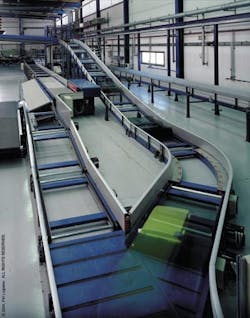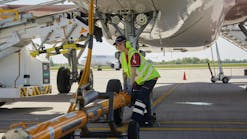Today's automated baggage handling systems play a critical role in alleviating the pressures placed on ground support personnel and in helping them increase passenger satisfaction. From check-in through screening to departure, arrival and claims, automated baggage handling systems help ground support teams around the world do their work quickly, safely and efficiently.
Modern automated baggage handling technologies range from sorting, conveying and tracking systems to explosives detection and early bag storage and retrieval. Together, the goal of a baggage handling systems provider is to make baggage handling as efficient and as transparent to passengers as possible. If things go smoothly in the baggage room, air travelers and ground support personnel have a lot less to worry about.
Automation Helps Improve Turnaround Times
Automated baggage handling systems help baggage handling and ground support personnel improve flight turnaround times. Highly accurate and efficient, automated baggage handling systems ensure the right bag goes to the right plane for the right passenger.
Baggage volume is perhaps the number one reason airports turn to automated baggage handling systems. Rising passenger traffic forces airport managers to think about improving efficiencies and assisting baggage handling and ground support crews in their daily tasks. In turn, it is the job of baggage handling providers to offer easy-to-use and easy-to-learn baggage handling systems and equipment.
Adding sortation and conveying technologies is generally the first step in the automation of a baggage handling system. However, with new government mandates for sophisticated baggage screening and explosives detection systems (EDS), these technologies are now frequently merged so that baggage sortation, conveying and screening becomes a completely in-line process that helps move baggage from check-in all the way to the ramp crews that load it on the planes.
Bar Coding and RFID
Radio Frequency Identification (RFID) is the major advance in baggage handling technology that has emerged over the last few years. While only a handful of airports around the world are using RFID, the technology is gaining momentum as an efficient way to optimize the baggage handling process beyond conventional technology based on bar-coded baggage tags.
RFID's ascension as the preferred baggage tracking technology can largely be attributed to its ability to provide virtually perfect end-to-end sorting, tracking and tracing. Because bar code-based systems require a line-of-sight read by a laser, damaged and folded-under bag tags result in read accuracies of only 85 to 90 percent. The remaining 10 to 15 percent leaves a wide margin for error in matching bags to the right passenger and flight.
RFID-based systems, because they use radio frequency waves and do not require a line-of-sight read, are able to read bag tags from virtually any vantage point, even those lying underneath a bag. As such, RFID-based systems avoid the potential for lost luggage that can occur with bar code-based systems, ultimately increasing passenger satisfaction.
In airports with significant passenger volumes, such as Las Vegas' McCarran International (LAS) which moves 65,000 bags a day, RFID is an increasingly compelling technology. McCarran is the first airport in the world to use an ultra-high frequency (UHF) RFID system for the identification, tracking and tracing of all outbound baggage. UHF RFID is considered the leading edge in secure radio frequency systems.
The Importance of Integration
While RFID is a true innovation, its application is amplified when used as part of an integrated baggage handling system. RFID's full potential can only be realized in systems with complete end-to-end integration of airline and airport systems information.
Complete integration in a baggage handling project takes an airport's disparate systems, such as flight scheduling and passenger information systems, and neatly joins them to one another, yielding a system that not only sorts and conveys baggage, but also provides tracking, tracing and detailed system performance information. This information is invaluable in helping airport crews correctly route passenger baggage and in ensuring maximum uptime for baggage handling equipment. Integrating technologies so that baggage handling operating systems match existing airport infrastructure also improves the speed with which a system can be installed and the ease of maintenance and repairs.
Tote-based baggage handling systems like the FKI Logistex CrisBag™ offer an integrated solution that puts every piece of baggage in a dedicated RFID-coded tote. In a CrisBag™ system, the baggage travels in the tote until it is loaded on the plane. CrisBag™ can also be used in an early bag storage system that stores and retrieves baggage according to flight schedules.
Checking In
At check-in, key advances in baggage handling include weighing and conveying systems that feature ergonomic designs for the convenience of ticket counter personnel and passengers. These systems streamline the check-in process, minimize passenger wait times and improve check-in counter efficiency, speed and accuracy.
Adding RFID baggage tags or RFID tag printers to the check-in process takes conventional bar code systems one step further. Making systems RFID-enabled starting at the baggage entry point provides near-100 percent sort-track-and-trace capability. Advanced check-in counter systems also feature the automatic association of weight and baggage tag information, including RFID data.
In European-style check-in systems, baggage is weighed on the conveyor that moves the bags to screening and sortation stations. With the passenger volumes that busy airports and airlines achieve, this translates to processing more passengers on time.
Systems Design and Layout
To make certain that a baggage handling system will operate at peak efficiency, a lot of time should be spent looking at how best to optimize system performance and reliability. Part of that process is understanding where the critical points are and designing a system and layout that reduces downtime. Maximizing the ability of ground maintenance personnel to respond to failures is a key goal when designing any baggage handling project.
Another important way to meet the needs of ground support teams is to minimize the time and energy spent by ground personnel compensating for and fixing system failures, such as equipment needing repair. The best way to accomplish this is to build redundancy into a system by providing alternate routes for baggage and baggage handling information during system failures. Designing redundant controls, conveying, sorting and screening paths helps airport and ground crews avoid the cascading, costly and sometimes disastrous effect of delayed baggage missing connecting flights.
The Many Facets of Project Support
When designing projects, baggage handling providers strive to build systems with components that are known to be reliable and dependable, and that match as closely as possible with existing parts inventory. Another imperative is installing easy-to-understand diagnostics tools that give maintenance staff ongoing data on system reliability. When parts do fail, providing easy access to all of the common components and spare parts that maintenance staff need is critical.
Ongoing service, support and training also play key roles. For mission-critical systems like baggage handling, it is important to have full 24/7 service and support available, as well as a variety of training options, including web-based training. Service, support and training are as crucial after the sale as they are before it.
Getting "buy-in" from ground support personnel is also a vital part of the baggage handling systems design process. Inviting ground support crews to be part of the commissioning team helps during the training process and in the installation, implementation and maintenance of a project.
Adapting to Change
Like any system, an automated baggage handling system must be flexible and scalable to maintain its relevance and vitality. For instance, using variable frequency drives and motors allows a system to work at today's throughput speeds while also being ready to work at tomorrow's increased speeds. Building intelligence into a baggage handling system, such as smart controls and upgradeable software, gives it the flexibility to meet longer term needs.
Adapting to future needs is also essential in this era of changing economic, safety and energy requirements. Baggage handling equipment should be designed to power down when no bags are on the system, saving energy and wear and tear. Employing the latest advances in baggage handling equipment ensures the utmost level of worker safety. Today's evolving security concerns also add to the need for flexibility in the design of a baggage handling system.
It's All in the Details
Scores of important details go into the design and build of any successful automated baggage handling system. From robust equipment that stands up to repeated use to baggage make-up units built to be more accessible to baggage handlers, the careful design, planning and integration of a baggage handling system by an experienced provider can make all the difference.
For ground support personnel, paying close attention to their specific needs in the design of a baggage handling system can make their workday safer, easier and more efficient. Choosing a proven and experienced baggage handling provider is one way to ensure the needs of ground personnel are met and should always be a first step in planning an automated baggage handling project.





